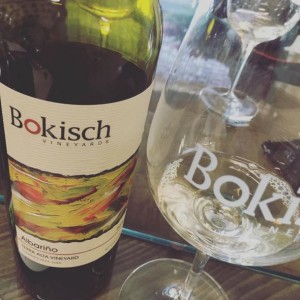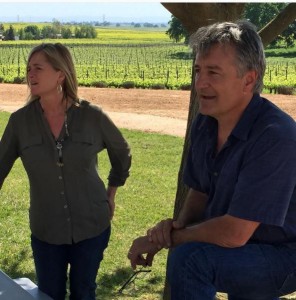
With this pre-disposition to love the rich wines of Spain, Markus moved to Spain with his wife Lisa and worked his way up in the Spanish wine industry. With endeavors in Raimat and Penedes, he became and expert at the cultivation of these special varietals. When he moved back to California, he knew that Lodi had something special – hidden behind 100 years of old Italian field blends and Zinfandel, and that it was the perfect location to begin his endeavor with Iberian varietals.
The Terra Alta Vineyard in Clements Hills was the first property they purchased, wherethey imported Spanish budwood to firmly root Bokisch as the go to resource for these plantings. In 1999, they planted Las Cerezas Vineyard, which is the motherblock, planted to Tempranillo, Albarino, and Graciano – classic Spanish grapes. Two years later, the first vintage of Bokisch Vineyards wine was released.
I first tasted Bokisch wine shortly after that initial release, when I was part of the now (sadly) defunct Wine Q wine service. I knew immediately, even though my palate was still developing in those early years of my wine career, that I would love what was to come.
Here we are, 8 years later, and I am lucky enough to taste the current releases of Bokisch frequently through a variety of tastings. On this day, we enjoyed two different Albarinios – the first being from the Terra Alta Vineyard, where the tasting room is located, and the second from Las Cerezas, that motherblock planted in 1999. While they were both welcome refreshers on this warm day, the Las Cerezas edged out the Terra Alta, with intensely tropical notes, and juicy fruit with lime zest and firm minerality on the finish.
Next, the Garnacha Blanca – a personal passion of mine – was a clear expression of how terroir impacts the finished product. The medium body was full of fresh stone fruit, oranges, and pungent green herbs. The creamy finish is perfect for cheese, hearty fish dishes, and just plain summer sipping. Stylistically, Garnacha Blanca tends to be bolder than it’s cousin Grenache Blanc, and I appreciate the weight and texture.
The age old question of Portuguese Verdelho vs. Spanish Verdejo is often an easy one to confuse, as they are both whites that come from Europe. Verdelho stems back to Portugal and has been used in Madeira for centuries; it’s a full body wine with hints of sweetness on the nose. In contrast, Rueda based white grape Verdejo traces its roots back further than most Europeans would suspect- all the way North Africa! It carries more crisp fruit flavors but still retains some sugar undertones (though not nearly as much).
Having the opportunity to taste these side by side at Bokisch Vineyards was a rare treat!
Moving on to the reds, Garnacha (once again) holds a special place in my heart. Whether it’s Grenache, Garnacha, or GSM, the varsity of styles it can be made in – let alone Grenache Blanc, Grenache Gris, and Grenache Noir (or Tinto), the diversity is delicious. Tracing its origigans to the Aragon region of Spain, the Bokisch Garnacha fils your mouth with blackberries, boysenberries, and dark red fruit. A finishing touch of blood orange and forest spices tease the palate as vanilla vapors envelop your senses. I love to serve Garnacha with a slight chill, and of course, anything is better with fresh Manchego cheese.

A bolder red wine, Graciano is one of the grapes commonly used as a blending component in parts of Rioja. It’s also thought to be the oldest variety commercially grown in Spain. A deeply purple black wine in the glass, bittersweet chocolate, Mission figs and cherries, with a hint of fresh violets tempt you, while tobacco and old saddle leather round out the palate. Graciano is a meaty grape, and this is a fantastic wine for steak and a classic Rioja cookout.
And now: Mourvedre. Mataro. Monastrell! Depending on where you are in the world, this blue hued grape is called different things. In France, Mourvedre. In Spain, it can be either Mataro, particularly in the Catalan dialect, or Monastrell. The 2013 Belle Collne Vineyard Monastrell is classically blueberry, bergamot, and baking spices.
The passion and dedication of Markus and Liz are infectious. His single focus of making Lodi a top wine destination of distinction, and their dedication to sustainability is second to none. Keeping these wines affordable is also of critical importance, and with prices between $18-32, the QPR on these wines is outstanding.
If you are in Lodi, a stop at Bokisch is a must do ! The sweeping view from the picnic tables to the seven oak tress in the gently rolling hills is bliss, and it is less than two hours from the Bay Area.
